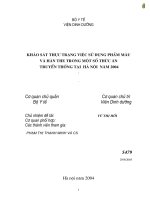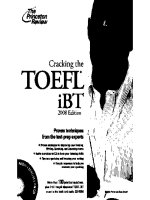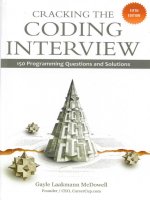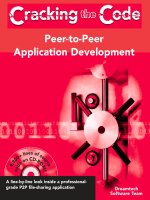Cracking the sat biology e m su the princeton review
Bạn đang xem bản rút gọn của tài liệu. Xem và tải ngay bản đầy đủ của tài liệu tại đây (7.61 MB, 554 trang )
Editorial
Rob Franek, Senior VP, Publisher
Mary Beth Garrick, Director of Production
Selena Coppock, Senior Editor
Calvin Cato, Editor
Kristen O’toole, Editor
Meave Shelton, Editor
Random House Publishing Team
Tom Russell, Publisher
Nicole Benhabib, Publishing Director
Ellen L. Reed, Production Manager
Alison Stoltzfus, Managing Editor
The Princeton Review, Inc.
111 Speen Street, Suite 550
Framingham, MA 01701
E-mail:
Copyright © 2013 by Itzy
Cover art © Jonathan Pozniak.
All rights reserved. Published in the United States by Random House, Inc., New York, and simultaneously in Canada by Random House of Canada
Limited, Toronto.
The Princeton Review is not affiliated with Princeton University.
eBook ISBN: 978-0-307-94572-3
Trade Paperback ISBN: 978-0-307-94552-5
SAT Subject Test is a registered trademark of the College Board, which does not sponsor or endorse this product.
Editor: Selena Coppock
Production Editor: Harmony Quiroz
Production Coordinators: Deborah A. Silvestrini and Todd Cubbison
v3.1
Acknowledgments
I dedicate this book to my children, James, Nicholas, Ian, and Rose, for redefining my role
as a teacher; and to my parents, Richard and Barbara Lewandowski, for giving me the faith
to believe that I can do whatever I set out to do. I love you all.
Thanks to Paul Kanarek for more help than I can list here, and thank you to Christi Pope,
Sarah Woodruff, and Dustin Yoon for their editing suggestions and help.
Special thanks to Adam Robinson, who conceived of and perfected the Joe Bloggs
approach to standardized tests and many of the other successful techniques used by The
Princeton Review.
Thank you to Caren Gough for her thorough content review for the 2013–2014
edition of this book.
Contents
Cover
Title Page
Copyright
Acknowledgments
Part I: Orientation
1
Introduction
Point 1: Approaching the Test Strategically
Point 2: Teaching You the Biology You Need to Know for the Exam
2
The Exam Format, Question Types, and Strategies
The Format
The Question Types
Strategy 1: Study the Right Stuff in the Right Way
Strategy 2: Practice the Right Stuff at the Right Time
Strategy 3: Easy Stuff First
Strategy 4: Take a Guess, but Guess Smart
Strategy 5: Choosing the “Wrong” Answer—LEAST/EXCEPT/NOT Questions
Strategy 6: I, II, III—You’re Out!
Strategy 7: Avoid the Camouflage Trap
Strategy 8: Avoid the Temptation Trap—Predict an Answer
Strategy Summary
Special Tips for Laboratory Five-Choice Questions
Part II: Subject Review
3
Molecules of Biology
Biologically Important
Biologically Important
Biologically Important
Biologically Important
Macromolecule #1:
Macromolecule #2:
Macromolecule #3:
Macromolecule #4:
Protein
Carbohydrate
Lipid
Nucleic Acid
4
Cell Structure
Eukaryotic Cell Structure
What Goes On in the Cytoplasm: Chemical Reactions and Enzymes
5
Cellular Respiration
Let’s Talk About Cellular Respiration
Glycolysis
The Pyruvate Dehydrogenase Complex (PDC)
The Krebs Cycle
Electron Transport and Oxidative Phosphorylation
What Happens If Oxygen Is Not Available?
6
Transcription and Translation
DNA Replicates Itself
Chromosomes and the Whole Organism: The Same Set in Every Cell
Chromosomes Come in Pairs: Homologous Chromosomes
How Chromosomes Govern Protein Synthesis: Transcription and Translation
Translation
How Translation Works, Part 1: tRNA
How Translation Works, Part 2: The Ribosome
7
Mitosis and Meiosis
How a Whole Cell Reproduces Itself: Mitosis
Genes, Proteins, and Chromosomes
But Where Did These Chromosomes and Their Genes COME From?
The Formation of Gametes: Meiosis
8
Cracking Genetics
Biology of Inheritance
Phenotype and Genes
Mating and Crossing: Predicting the Phenotype and Genotype of Offspring
Punnett Squares
Another Thing About Genetics and Inheritance: Sex and Sex-Linked Traits
Mendelian Genetics
Pedigree Analysis
9
Cracking Evolution and Diversity
The Origin of Life
Evolution
Getting Organized: Phylogeny
A. Kingdom Protista
B. Kingdom Plantae
C. Kingdom Fungi
D. Kingdom Animalia
10 Microorganisms
Let’s Talk About Fungi
Let’s Talk About Bacteria
Let’s Talk About Viruses
Cool Stuff: Recombinant DNA Technology
11 Organ Systems
Control of the Body, Part 1—The Nervous System
Control of the Body, Part 2—The Endocrine System
Transport Within the Body—The Circulatory System
Blood Typing
The Heart
Ventilation and Gas Exchange—The Respiratory System
Body Processing, Part 1—The Digestive System
Body Processing, Part 2—The Urinary System
Support and Protection of the Body, Part 1—The Skeletal System
Support and Protection of the Body, Part 2—The Muscular System
Support and Protection of the Body, Part 3—The Skin
Reproduction and Development, Part 1—The Male System
Reproduction and Development, Part 2—The Female System
Reproduction and Development, Part 3—Fertilization, Embryology, and Fetal
Development
12 Plants
Leaf Structure
13 Behavior
14 Cracking Ecology
What Is a Population?
What Is a Community?
More About the Community—Who’s Who
Let’s Talk About Ecological Succession
Getting Bigger—the Ecosystem
What Goes Around, Comes Around—Nutrient Cycles
Getting Bigger Again—Biomes
Part III: Answers to In-Chapter Questions
15 Answers to In-Chapter Questions
Part IV: The Princeton Review Practice SAT Biology E/M Subject Tests and
Explanations
16 Practice SAT Biology E/M Subject Test 1
17 Practice SAT Biology E/M Subject Test 1: Answers and Explanations
18 Practice SAT Biology E/M Subject Test 2
19 Practice SAT Biology E/M Subject Test 2: Answers and Explanations
About the Author
Part I
Orientation
1
2
Introduction
The Exam Format, Question Types, and Strategies
Chapter 1
Introduction
WHAT ARE THE SAT SUBJECT TESTS?
They are a series of one-hour exams administered by Educational Testing Service (ETS).
Unlike the SAT, the SAT Subject Tests are designed to measure speci c knowledge in
speci c areas. There are many di erent tests in many di erent subject areas, such as
biology, history, French, and math. They are scored separately on a 200–800 scale.
HOW ARE THE SAT SUBJECT TESTS USED BY COLLEGE
ADMISSIONS?
Because the tests are given in speci c areas, colleges use them as another piece of
admissions information and, often, to decide whether an applicant can be exempted
from college requirements. For example, a certain score may excuse you from a basic
English class or a foreign language requirement.
SHOULD I TAKE THE SAT SUBJECT TESTS? HOW MANY?
WHEN?
About one-third of the colleges that require SAT I scores also require that you take two
or three SAT Subject Tests. Your rst order of business is to start reading those college
catalogs. College guidebooks, admissions o ces, and guidance counselors should have
this information as well.
As to which tests you should take, the answer is simple:
1. Take those Subject Tests that you will do well on.
2. Take the tests that the colleges you are applying to may require you to take.
The best possible situation, of course, is when the two match.
Some colleges have speci c requirements, others do not. Again, start asking questions
before you start taking tests. Once you nd out which tests are required, if any, part of
your decision making is done. The next step is to nd out which of the tests will show
your particular strengths and to contact colleges to see which tests they suggest or
require. Evaluate your own strengths and skills. Possibilities range from English
literature, U.S. or world history, biology, chemistry, and physics to a variety of foreign
languages.
As for when, take tests that are as close as possible to the corresponding coursework you
may be doing. If you plan to take the SAT Chemistry Test, for example, and you are
currently taking chemistry in high school, don’t postpone the test until next year.
WHEN ARE THE SAT SUBJECT TESTS OFFERED?
In general, you can take from one to three Subject Tests per test date in October,
November, December, January, May, and June at test sites across the country. Not all
subjects are offered at each administration, so check the dates carefully.
HOW DO I REGISTER FOR THE TESTS?
You can register at the College Board website at www.collegeboard.com. This site
contains other useful information such as the test dates and fees. If you have questions,
you can talk to a representative at the College Board by calling 866-630-9305.
You may have your scores sent to you, to your school, and to four colleges of your
choice. Additional score reports will be sent to additional colleges for, you guessed it,
additional money. The scores take about five weeks to arrive.
A Couple of Words About Score Choice
As of February 2009, you can choose which SAT Subject Test scores you want colleges to
see. This is great news! For one thing, if you take more than one SAT Subject Test on a
given date, you’ll be able to choose which tests from that date you’d like to submit to
colleges. So if, for example, you take the Biology M test followed by the French test, but
you don’t think that the French test went very well, you can simply opt out of having
that French scores sent to your schools.
This score reporting policy is optional for students. This means that you aren’t required
to opt in and actively choose which speci c scores you would like sent to colleges. If you
decide not to use the Score Choice reporting feature, then all of the scores on le will
automatically be sent when you request score reports.
For more information about this score-reporting policy, go to the College board website
at www.sat.collegeboard.org/home.
WHAT’S A GOOD SCORE?
That’s hard to say, exactly. A good score is one that falls within the range of scores the
college of your choice usually accepts or looks for. However, if your score falls below the
normal score range for Podunk University, that doesn’t mean you won’t get into Podunk
University. Schools are usually fairly exible in what they are willing to look at as a
“good” score for a certain student.
Along with your score, you will also receive a percentile rank. That number tells you
how you t in with the other test takers. In other words, a percentile rank of 60 means
that 40 percent of the test takers scored above you and 60 percent scored below you.
WHAT IS THE PRINCETON REVIEW?
The Princeton Review is a test-preparation company based in New York City. We have
branches across the country and abroad. We’ve developed the techniques you’ll nd in
our books, courses, and online resources by analyzing actual exams and testing their
e ectiveness with our students. What makes our techniques unique is our approach. We
base our principles on the same ones used by the people who write the tests. We don’t
want you to waste your time with super uous information; we’ll give you just the
information you’ll need to get great score improvements. You’ll learn to recognize and
comprehend the relatively small amount of information that’s actually tested. You’ll also
learn to avoid common traps, to think like the test writers, to nd answers to questions
you’re unsure of, and to budget your time effectively.
You need to do only two things: trust the techniques, and practice, practice, practice.
CRACKING THE SAT BIOLOGY SUBJECT TESTS
This book is for students who want to raise their scores on the SAT Biology Ecological
(Biology E) Subject Test or SAT Biology Molecular (Biology M) Subject Test. At The
Princeton Review, we know what standardized test makers are up to. That’s because we
study their tests. We know how these tests are put together, and we’ll use that
information to help you raise your score.
How exactly will we do that? In two ways:
1 We’ll show you how to approach the test strategically.
2 We’ll teach you the biology you need to know to do well on the exam.
TO E OR NOT TO E?
As a student of biology, you can opt to take either the Biology E (Ecological) test or the
Biology M (Molecular Biology) test. You may not take both tests on the same test day.
Here’s how you should decide which test to take:
Take the Biology E test if you are more comfortable with questions about energy ow,
biological interactions, and populations and communities. This section of the biology
test is focused on ecology.
Take the Biology M test if you are more comfortable with topics such as biochemistry,
cellular biology, and processes such as photosynthesis and respiration. This section of
the test concentrates on molecular biology.
POINT 1: APPROACHING THE TEST STRATEGICALLY
You can improve your score on any multiple-choice exam by knowing a few basic
strategies and test-taking techniques. The SAT Biology E/M Subject Test is no di erent.
You should study the types of questions that show up on the exam, you should be wise to
their design, and you should be familiar with the techniques that systematically lead to
correct answers.
When you sit down to take the SAT Biology E/M Subject Test, you’ll see some questions
whose answers you don’t know right away. Without knowing the techniques that
improve your chances of getting the correct answer, you might panic. In Chapter 2 of
this book, we’ll show you eight strategies that will help you outsmart the SAT Biology
E/M Subject Test. Learn our strategies, and if you do see an unexpected question or a
question that tests an unfamiliar topic, you won’t panic. Why? Because you have the
ammunition you need to improve your chances of getting the right answer.
Practice and Practice Tests
This book is interactive. We rehearse you over and over again on the subjects and
strategies we teach. We don’t present a long array of drill questions at the end of a
chapter. Instead, we watch your progress paragraph by paragraph, page by page. We
take what you need to know and drive it into your head, word by word, and sentence by
sentence.
We also present two full-length practice SAT Biology E/M Subject Tests in Chapters 16
and 18. They’re complete with solutions and explanations that don’t just give you the
right answer but also remind you of the strategies and techniques you should be
applying to help you solve the question.
Should I Buy Practice Material from ETS?
It’s not a bad idea. If you want to take additional tests beyond the ones we provide,
then buy The O cial Study Guide for All SAT Subject Tests, Second Edition, which is
published by the College Board. You can go to the College Board’s website,
www.collegeboard.com, for more information and practice questions. Take the SAT
Biology E/M SAT Subject Test and see how much easier it is after you’ve read and
studied this book.
POINT 2: TEACHING YOU THE BIOLOGY YOU NEED TO
KNOW FOR THE EXAM
ETS says its SAT Biology E/M Subject Test covers, among many other topics, aerobic
respiration, anaerobic respiration, and the biochemical differences between the two.
If you sat with your biology textbook and read about these subjects, you’d read about a
whole lot of information that de nitely will not be tested. You’d read about the roles of
various enzymes, coenzymes, and cofactors. You’d see pictures like the one on the
following page.
And you’d read text like this:
Glycolysis is a prime illustration of the manner in which vital biochemical processes
occur through a series of steps. The complete catabolism of glucose may be considered to
embody nine steps. We’ll examine the details of glycolysis and notice that the 6-carbon
skeleton of the glucose molecule is sequentially degraded, each step being catalyzed by a
speci c enzyme, to produce adenosine triphosphate (ATP) via the phosphorylation of
adenosine diphosphate. Blah, blah, blah … acetyl CoA … blah, blah, blah … NADH and
NAD+, blah, blah, blah … FADH2 … blah, blah, blah … cytochrome carrier system, blah,
blah, blah …
The text would go on and on, scaring and boring you, but o ering nothing that would
help you raise your test score. You’d become so sick of it that you’d stop reading (which
is fine, because reading your textbook might not help you raise your score anyway).
When we teach you about aerobic and anaerobic respiration, we’ll tell you exactly what
you have to know, and a little bit beyond (just to make sure there are no surprises on
test day). As we do that, we drill you with questions and quizzes so you can check your
understanding as you go along. The details that won’t be tested are left out so that you
can focus on understanding and remembering the main points: the material that will be
tested. We’ll summarize and list these important points for you so that they stand out.
At the end, you’d know that both aerobic and anaerobic respiration involve breaking
down glucose to form ATP. You’d also know that aerobic respiration has to do with
(1)
(2)
(3)
(4)
(5)
the presence of oxygen,
more ATP,
the Krebs cycle,
the electron transport chain, and
oxidative phosphorylation.
And you’d know that anaerobic respiration has to do with
(1) the absence of oxygen,
(2) less ATP, and
(3) lactic acid.
Even without completely understanding the biochemical di erences between the two
processes, these simple associations can help you answer questions. Review the few
summary lines above about aerobic and anaerobic respiration, then answer these two
SAT Biology E/M Subject Test–like questions:
Among the following, which is associated with BOTH aerobic and
anaerobic respiration?
I ATP production
II Krebs cycle
III Oxidative phosphorylation
(A)
(B)
(C)
(D)
(E)
I only
II only
I and II only
II and III only
I, II, and III
Which of the following substances is produced as a result of anaerobic
respiration but NOT of aerobic respiration?
(A)
(B)
(C)
(D)
(E)
Carbon dioxide
Lactic acid
ATP
Glucose
Glycogen
The answer to the rst question is A. Both anaerobic and aerobic respiration produce
ATP, but only aerobic respiration is associated with the Krebs cycle and oxidative
phosphorylation. The answer to the second question is B. Anaerobic respiration is
associated with the production of lactic acid, and aerobic respiration is not. (Note that
on this question, you may not have known about carbon dioxide or glycogen. But you
did know that you could eliminate ATP and glucose as choices, and that lactic acid t
the criteria described in the question, making it a better choice than carbon dioxide or
glycogen. We’ll talk more about this technique later on.)
Our Job and Your Job
This book is designed to help you raise your SAT Biology E/M Subject Test score. It’s
written, it’s published, and you’re holding it in your hands. That means our job is done.
Your job is to read it, study it, tackle the questions and practice exams, and learn what
it has to teach. We had fun doing our job, and believe it or not, you’ll have fun doing
yours. So, let the fun begin!
For book updates, links to more information, and last-minute test changes, visit our
website at www.princetonreview.com/college-education.aspx.
Chapter 2
The Exam Format, Question Types, and
Strategies
THE FORMAT
The SAT Biology E/M Subject Test consists of a total of 100 questions: a common core of
60 questions followed by 20 questions in each of the two specialty sections. Everyone
who takes this exam has to answer the 60 core questions, but you get to choose the
specialty section you feel more comfortable with: Ecology or Molecular Biology.
Altogether, then, you answer only 80 of the 100 questions: the 60 core questions and the
20 questions from your chosen specialty group. You have 60 minutes to complete these
questions. Detailed instructions for choosing your specialty section will be given to you
on the day of the exam.
THE QUESTION TYPES
There are three types of questions that are used in the SAT Biology E/M Subject Test:
• Classification questions
• Five-choice questions
• Laboratory five-choice questions
Classification Questions
This type of question is sort of like a little “matching test.” A list of ve words or
phrases is set up, lettered A through E, or a diagram is shown with labels A through E.
For each list or diagram you get three or four questions, with question numbers next to
them. But the questions aren’t really questions, they’re phrases—half-sentences. Your job
is to match the phrase in the question with the word or phrase that appears in the list A
through E, or on the diagram A through E. Here’s
an example:
Directions: Each set of lettered choices below refers to the numbered statements
immediately following it. Select the one lettered choice that best ts each statement and
then ll in the corresponding oval on the answer sheet. A choice may be used once,
more than once, or not at all in each set.
Questions 1-3
(A)
(B)
(C)
(D)
Thyroid
Adrenal cortex
Pancreas
Ovaries
(E) Parathyroid
1. Secretes glucagon
2. Regulates metabolism
3. Structure producing female gametes
The answers are C, A, and D. But don’t worry about the answers right now. We just
want you to know how this type of question looks. You’ll probably get about four of
these little “matching tests”—about 16 classi cation questions in all—when you take the
SAT Biology E/M Subject Test.
Five-Choice Questions
There are ve di erent types of ve-choice questions. The
looking. Here are a couple of examples:
rst type really is ordinary-
Directions: Each of the questions or incomplete statements below is followed
by ve suggested answers or completions. Select the one that is BEST in each
case, and then fill in the corresponding oval on the answer sheet.
Which of the following terms describes the process by which the plasma
membrane moves substances inward, against a concentration gradient?
(A)
(B)
(C)
(D)
(E)
Facilitated diffusion
Active transport
Osmosis
Simple diffusion
Autotrophism
The endocrine organ that secretes antidiuretic hormone is the
(A)
(B)
(C)
(D)
(E)
adrenal cortex
pancreas
posterior pituitary gland
kidney
liver
The correct answers are B and C, but it doesn’t matter right now whether you know
that. (You will know, after you’ve nished studying this book.) Again, we just want you
to know what this type of question looks like.
T h e second type of ve-choice question is a twist on the rst type, called a
LEAST/EXCEPT/NOT question. This is a basic multiple-choice question, except that in
this case you’re looking for the wrong answer—the one that doesn’t t the statement
given in the question. Here’s an example:
All of the following are functions of the liver EXCEPT
(A)
(B)
(C)
(D)
(E)
producing bile
storing glycogen
making blood proteins
secreting insulin
storing vitamins
In this question, the wrong statement (and therefore the correct answer choice) is D. The
liver does everything listed except secrete insulin; that’s a function of the pancreas.
(You’ll know that, of course, after you read Chapter 11.)
The third type of five-choice question is a I, II, III question, such as the following:
Which of the following nitrogenous bases are found in DNA?
I Thymine
II Cytosine
III Uracil
(A)
(B)
(C)
(D)
(E)
I only
II only
I and II only
I and III only
I, II, and III
The correct answer here is C, but again, don’t worry about that now.
The fourth type of ve-choice question presents a numbered diagram with two or three
questions following it:
Questions 25-26 below refer to the following diagram.
25. Which structure contains female monoploid nuclei?
(A)
(B)
(C)
(D)
(E)
1
2
3
4
5
26. Pollen grains are produced by
(A)
(B)
(C)
(D)
(E)
1
3
4
5
6
The answers for the above questions are D and A. The core exam will present you with
about 10 to 12 of these ve-choice questions, and each of the specialty sections may
have another four to six.
Laboratory Five-Choice Questions
These questions are designed to see if you can think logically about biological
experiments. First you’re told about an experiment. You are usually shown a gure,
graph, or data table that goes along with it. Then you’re asked two to four ve-choice
questions about the experiment. The questions can be in any of the three formats
already discussed. Here’s an example:
Questions 30-31 refer to an experiment in which the process of evolution
is studied by working with anaerobic bacteria.
A small colony of bacteria is placed on Plate 1, which contains a suitable
culture medium. After 10 days, approximately half the bacteria are removed
from Plate 1 and transferred to Plate 2, which contains both a suitable culture
medium and a potent antibiotic related to penicillin.
30. Over the course of time, both Plates 1 and 2 should show an increase in the
concentration of
(A)
(B)
(C)
(D)
(E)
ADP
carbon monoxide
lactic acid
Krebs cycle enzymes
oxygen
31. Which of the following graphs of time versus population is most likely to
describe the growth of the colony after inoculating Plate 1 ?
(A)
(B)
(C)
(D)
(E)
The answers for the previous questions are C and E. The questions associated with
experiments require that you be able to (1) read a graph or data table, and/or (2)
exercise a little logic with the biology you know.
The core exam has about 25 to 30 laboratory ve-choice questions (about ve or six
different experiment descriptions) and the specialty sections each have about 14 to 16 of
these questions (about three or four different experiment descriptions).
THE STRATEGIES
Strategy 1: Study the Right Stuff in the Right Way
Biology is a vast subject. In other words, there is a LOT that could potentially end up on
the SAT Biology E/M Subject Test—like everything that’s in your biology textbook and
more. So should you sit down and read your textbook cover to cover and memorize all of
it? NO!
We’ve mentioned this before—your textbook goes into a lot of detail that will not be
present on the SAT Biology E/M Subject Test. Memorizing it would be a waste of time.
At The Princeton Review, we’ve studied the SAT Biology E/M Subject Test, and we know
the subjects that are most likely to appear on it. In this book, we’ve taken these topics
and explained them in a way that is easy to understand and remember, and we’ve
provided you with summaries of the most important points. Many of the little details
that will not be tested are left out. This way you can get the big picture and understand









